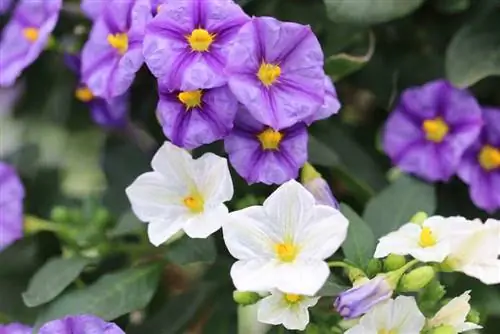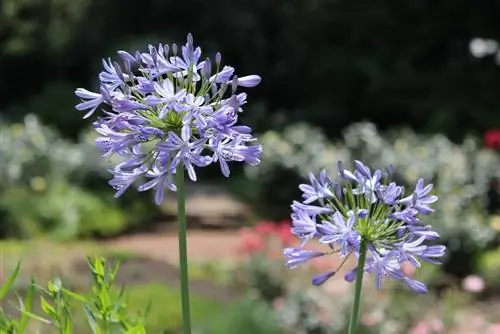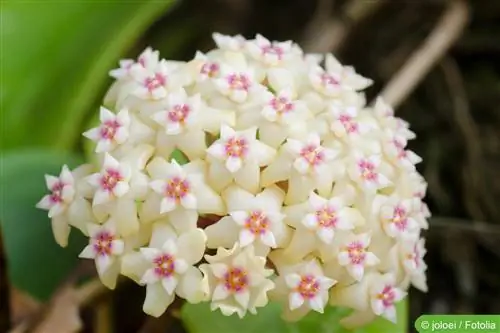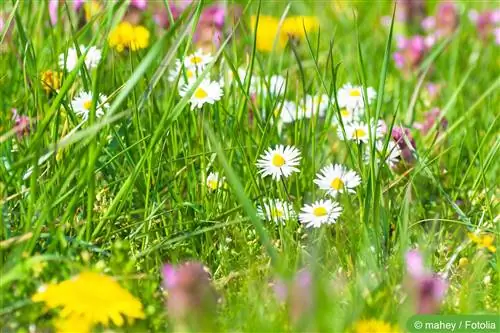- Author admin [email protected].
- Public 2023-12-17 03:39.
- Last modified 2025-01-24 12:45.
Potato flower, potato tree, gentian bush or Solanum rantonetti - the blue-flowering plant is a feast for the eyes under any name. With its lush flowers and yellow eyes, the plant is guaranteed to attract attention. And that over a long period of time. Because with optimal care, the flowering period does not start very early, it can extend into the winter. If you want to enjoy this beauty, you don't have to do a lot of care, but you do have to do the right care. This makes cultivating the potato flower ideal for beginners and gardening enthusiasts without a green thumb.
Location
If you want to observe a particularly magnificent and lush bloom on the potato flower, you should choose the sunniest location you can find. Even in summer, blazing sun is no problem for the gentian bush, but shade is. Although it doesn't die down immediately, it does lose some of its flowering power. It should also be noted that the potato tree can be quite large. Sufficient space should therefore be provided. The plant also needs stabilization, especially when cultivated as a standard stem. A trellis to which a few shoots are securely attached is suitable. The potato flower can also benefit from a low fence or trellis in the balcony box. At least stronger ones can't do too much harm to the shoots.
Substrate
When choosing the planting substrate, the potato flower is anything but demanding and complicated. Commercial potting soil is completely sufficient for you. If you want to make it a little easier for yourself when fertilizing in the future, add a portion of well-rotted compost to it.
Pouring
The potato flower is not picky when it comes to the lime content of the water. Soft rainwater or hard tap water, it doesn't matter to the gentian bush. But the plant needs plenty of water. The substrate must not dry out completely in summer or winter. Especially in the blazing sun and on hot days, this can require several waterings per day.
Tip:
If you don't want to go through the hassle of watering, you should use planters with a reservoir.
Fertilize
The gentian bush has a very high nutrient requirement and therefore needs to be fertilized frequently, at least during its flowering period. It is ideal to add a liquid complete fertilizer for flowering plants to the irrigation water once a week. If you don't want to go to this trouble or forget to fertilize often, you can alternatively use an appropriate slow-release fertilizer in stick form.
Intersection
The potato tree doesn't actually need a trimming, but it's extremely good for it and can promote attractively dense growth. It is advisable to shorten around one to two quarters of the shoot length when bringing it into the winter quarters. If the potato flower is taken outside again in spring, it can be gently trimmed again. In particular, damaged and dead shoots must be removed. Corrections and gentle pruning are also possible during the warm season.
Propagate

The potato flower can be easily propagated from spring to summer using top cuttings. To do this, shoots about ten centimeters long are cut off and placed in potting soil. In a location with 20 °C to 25 °C and sufficient light, the cuttings root quickly. Provided they are kept slightly moist at all times. Newly sprouted leaves are a sure sign that roots have formed. If the original cuttings have doubled in size, they can be transplanted into the substrate described above.
Tip:
Rooting in water, which is often recommended, has a significantly lower success rate. Once roots have formed here, the young plants can be placed in potting soil immediately afterwards.
Wintering
The potato flower can tolerate short-term light frost, but loses a lot of strength. Wintering should therefore take place indoors at a temperature between 5 °C and 15 °C. Ideally in a bright room. If you continue to water it here, the flowers can even last long into the winter. In addition, the potato tree will sprout and bloom again early the following spring. If you don't have enough space to overwinter the gentian bush in a bright place and at relatively high temperatures, you don't have to. The plant also does well in a dark room, but the temperature should be at least 5 °C. However, this affects growth and the onset of flowering and both occur later the following year. Whatever you choose, the substrate must not dry out during the winter. However, fertilization must be stopped.
Repotting
Repotting is usually necessary every two years at the latest. On the one hand, it is important that the old substrate is completely removed. This measure prevents any existing germs and pests from moving into the new pot. On the other hand, the new flower pot should be only slightly larger than the old one. This means that the roots can only expand to a limited extent and flowering is only slightly restricted. Repotting is best done in spring, between May and April.
Typical diseases, pests and care errors
The potato flower can be attacked by lice, whiteflies and red spiders. With regular checks, these are quickly noticed and can be combated at an early stage. Natural predators are primarily effective, including predatory bugs, ladybirds, parasitic wasps and lacewings. If the pests occur in the winter quarters, the release of the beneficial insects is of course very unfavorable. Organic oil-based insecticides can help here.
The gentian bush is rarely affected by diseases. Fungal infections are only likely if the plant is constantly too wet or too dark. The best prevention and control here is to maintain optimal culture conditions. For additional strengthening, it is also a good idea to use nettle manure as fertilizer once a month and to remove damaged parts of the plant. Regular substrate change continues to be effective against pests and diseases.
Frequently asked questions
Is the potato flower poisonous?
The potato flower is poisonous to humans and animals and is therefore only safe to a limited extent for households and gardens with pets and small children. In any case, it should be kept out of their reach and attention must also be paid to falling flowers and leaves.
Why doesn't the potato tree bloom?
The most common reasons for the gentian bush not blooming are a location that is too dark and too cool. If the plant receives both enough light and enough warmth, it can bloom from April to November. However, a lack of nutrients can also cause a decline in flowering power. First and foremost, the conditions at the location and the fertilization must be checked.
What you should know in brief
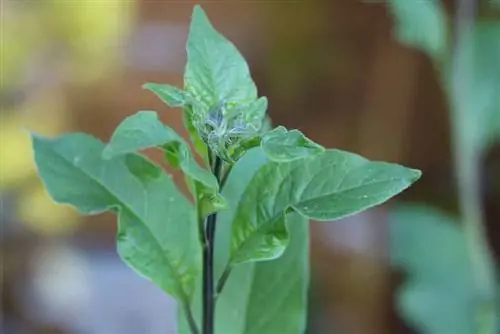
The potato flower is often used on balconies and terraces because it blooms from April throughout the summer until November. Although it can also be planted in the garden, it is not hardy.
Care
- The potato flower is very easy to care for, but should be fertilized once a week and of course watered regularly.
- It is suitable for full sun locations and grows very upright.
- For planting balcony boxes, five to six plants are required per meter, provided the potato flower is not combined with other plants.
- It is also sold on a standard tree and can then be used as a potted plant to decorate the balcony or terrace.
- With good care and regular fertilization, it will bloom until the onset of frost.
- If it is located in the winter garden, even longer, provided it is placed in a south-facing window.
- The potato flower needs a lot of water, especially in summer, but is quite undemanding when it comes to water quality.
Tip:
To ensure a sufficient supply of nutrients, either a liquid flower fertilizer for irrigation water or a slow-release fertilizer can be used.
Cut
- Before the potato tree is moved to its winter quarters, it should be cut back by a good half.
- A standard tree that needs to be shaped can then be trimmed again in the spring.
- At the same time, the potato flower can also be repotted, which is necessary about every one to two years.
- The new pot should be only slightly larger than the old one so that the plant does not use up all its energy for root growth.
Wintering
- The potato flower can only tolerate very light frost and must therefore be brought into winter quarters before the first night frosts.
- It should be bright and cold there, but a temperature above 0° C is absolutely necessary.
- A bright location ensures that the plant will bloom again from April.
- However, it may be that the flowering starts later the following year.
- During the winter months, the plant needs to be watered from time to time so that it does not dry out completely.
At the end of winter it can be put outside again and then usually grows even better than in the first year and produces more flowers. To support it, it should be fertilized regularly, especially in the second year.

